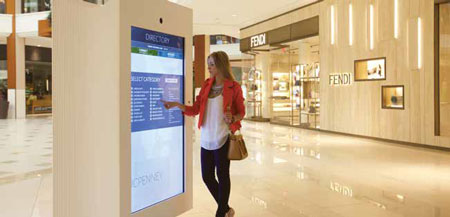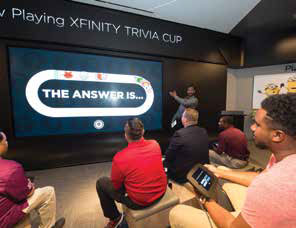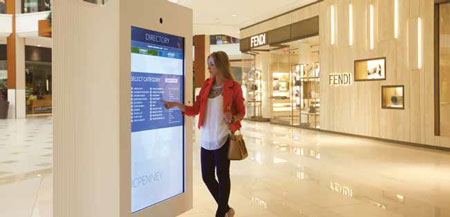As creative integrators look at ways to grow alongside a digital signage market that is seeing innovations in technology grow rapidly, one vertical to keep an eye on is retail. More and more people are doing their shopping online, which poses a challenge for brick-and-mortar stores: How do they draw people off of their couches and into their shops? Many savvy businesses are turning toward digital signage.

At the Aventura Mall, integrator CMA Digital installed dual-sided, interactive digital directories at each of the mall’s entrances, featuring a Planar large-format display that provides touch-based wayfinding maps on one side and advertising on the other. “We’re trying to create a destination, rather than just a shopping trip,” said TJ DiQuollo, manager, creative services at Diversified, a California-based integrator that has done a wide range of projects in the retail sector. “How do we convince people that it can be worth their time to come into a store and experience the brand?”
Though there’s no one secret solution, the old saying that “the customer’s always right” feeds into what retailers are looking for when they’re pricing a digital signage installation. They’re seeing what the public is after and are requesting that for their stores. Right now, that means interactivity.
“Smartphone and tablet proliferation have created the expectation among consumers that screens should be interactive,” said BrightSign CEO Jeff Hastings. “The ability to touch, swipe, and pinch/zoom are now intuitive behaviors that are making their way into the digital signage market. We expect this shift to gain momentum in the months and years ahead.”
Much like its growing ubiquity in the personal technology world, that touchscreen mindset has already planted a stake in digital signage displays, and as more customers and retailers see them, the more they come to expect them.
“Touch interactivity is increasingly becoming more mainstream in retail and hospitality settings, with consumers expecting an interactive digital experience in hotels, stores, malls, etc.,” said Jennifer Davis, vice president, marketing and product strategy at Planar and chief marketing officer at Leyard International. “Demand has accelerated for touch displays of varying sizes, ranging from small touchscreens used in kiosks to large-scale video walls, and all other sizes in between.”
Wayfinding remains a top priority in large spaces like shopping malls, where retailers have the opportunity to attract shoppers with helpful, interactive information, while also integrating advertising and other messages into the display—adding potential revenue for the venue.
“Interactive touch experiences are a big part of our business and the benefits to customers are numerous,” said Davis. “Experience design, omnichannel retail trends, and the desire for deeper and more meaningful customer engagement are all enhanced with touch.”
The technology is booming beyond touch, though. Much in the same way touchscreens are so common in consumers’ daily lives, so is social media, and retailers know that’s a goldmine for collecting information about their customers, as well as gaining and retaining them.
“Brands are leveraging their social media, and the retail space is a place for that to converge to create an experience that people value,” DiQuollo said. “We feel the best way is with user-generated content because it promotes the brand in the store and out of the store. It could be something as simple as sharing social media within the store, expressing emotion about the brand positively, reinforcing the brand’s values through that social media. Maybe you come in, put in your Instagram account, and you can have an experience tailored to you in front of you on the display. That creates that one-to-one relationship. It allows people to interact with the brand in a public setting.”
Catering to a shopper’s ingrained habits is the intuitive part of this digital signage evolution. As more consumers rely on mobile phones for entertainment, information, and social interaction, they’re becoming more interested in continuing that type of engagement in a retail environment.
“Customers are asking for self-service kiosks, mobile app integration, and most of all, convenience,” Hastings said. “Customers also want to encounter digital signage as an experience. Interactive experiences are generally more memorable and satisfying for the enduser.”
To that end, Hastings sees a shopper’s mobile interactivity as a leading influencer for technology development.
“Short-range wireless communications will drive the next generation of digital signage,” he said. “In particular, the use of beacons and Bluetooth will drive new use cases in the digital signage space.”

At the flagship store for Xfinity, Diversified helped work on a digital signage installation that includes gaming features, interactive control via iPads, and more. He explained how a BrightSign player paired with a mobile app can deliver two-way communication between the customer and the digital sign, so shoppers can receive messages from the sign, can manipulate content on the sign, and even order items directly from it.
“Not only does this enable a virtual dialogue with the consumer, it also opens up the possibility of engaging with consumer hours or days later,” Hastings said. “This sort of long-tail engagement simply wasn’t possible until now.”
Diversified’s DiQuollo predicts the next big development is the expansion of gesture-based technology. While he’s seen it at work on largerscale projects, he anticipates it will end up in more small-scale installations—for instance, working in more ideas like the Magic Mirror, where customers can try clothes on virtually and receive a personalized shopping experience.
“You’re going to see that being experimented with more in the coming years,” he said. “For me, that is probably the most exciting thing—taking the interaction from touch to gesture.”
Enhancing the experience for the shopper is one part of the puzzle, but showing a return on investment is another. If a business is going to spend money on a display, it needs to be able to quantify it, to know if it converted into a sale. Data capture through mobile phones is one major avenue—who are those Instagram followers that used the company’s hashtag in the store, or that person who just placed the order from the in-store signage?
“Data is huge,” DiQuollo said. “That’s the next gold rush. Everybody wants to capture as much data about their customers as possible.”
In addition to mobile phone interactions, he explained that another option is becoming more prevalent: using cameras in front of screens to gather demographic data, as well as movement tracking, to see who’s buying (or not buying) what and where in the store.
“Figuring out where people go, how long they dwell—that’s very relevant information we help them capture,” he said. “We can help that company identify and capture the data, through sensors and cameras, of who’s walking in, who’s walking out, if people are congregating toward this area of the store. That’s valuable for product placement, and to figure out what’s the best flow. We can do that through a bunch of technologies, and those are really starting to ramp up.”
Ensuring analytics like that are part of a digital signage installation is only going to become more important as manufacturers figure out new ways to use technology to collect data.
“That’s how these retailers are justifying spending the money on these experiences,” DiQuollo said. “Because at the end of the day, you still need to sell stuff.”
Mary Bakija is a freelance writer based in Brooklyn, NY.
